
The sugar-apple or sweet-sop is the fruit of Annona squamosa, the most widely grown species of Annona and a native of tropical climate in the Americas and West Indies. Spanish traders aboard the Manila galleons docking in the Philippines brought it to Asia. The fruit is spherical-conical, 5–10 cm (2.0–3.9 in) in diameter and 6–10 cm (2.4–3.9 in) long, and weighing 100–240 g (3.5–8.5 oz), with a thick rind composed of knobby segments. The color is typically pale green through blue-green, with a deep pink blush in certain varieties, and typically has a bloom. It is unique among Annona fruits in being segmented, and the segments tend to separate when ripe, exposing the interior.

Annona is a genus of flowering plants in the pawpaw/sugar apple family, Annonaceae. It is the second largest genus in the family after Guatteria, containing approximately 166 species of mostly Neotropical and Afrotropical trees and shrubs.

Custard apple is a common name for a fruit, and the tree which bears it, Annona reticulata.

Annona squamosa is a small, well-branched tree or shrub from the family Annonaceae that bears edible fruits called sugar-apples or sweetsops. It tolerates a tropical lowland climate better than its relatives Annona reticulata and Annona cherimola helping make it the most widely cultivated of these species. Annona squamosa is a small, semi-(or late) deciduous, much branched shrub or small tree 3 metres (9.8 ft) to 8 metres (26 ft) tall similar to soursop.
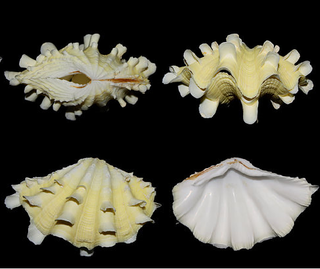
Tridacna squamosa, known commonly as the fluted giant clam and scaly clam, is one of a number of large clam species native to the shallow coral reefs of the South Pacific and Indian Oceans. It is distinguished by the large, leaf-like fluted edges on its shell called 'scutes' and a byssal opening that is small compared to those of other members of the subfamily Tridacnindae. Normal coloration of the mantle ranges from browns and purples to greens and yellows arranged in elongated linear or spot-like patterns. Tridacna squamosa grows to 40 centimetres (16 in) across.

The scaly-naped pigeon, also known as the red-necked pigeon, is a bird belonging to the family Columbidae. The species occurs throughout the Caribbean.

MicroRNA (miRNA) precursor miR156 is a family of plant non-coding RNA. This microRNA has now been predicted or experimentally confirmed in a range of plant species. Animal miRNAs are transcribed as ~70 nucleotide precursors and subsequently processed by the Dicer enzyme to give a ~22 nucleotide product. miR156 functions in the induction of flowering by suppressing the transcripts of SQUAMOSA-PROMOTER BINDING LIKE (SPL) transcription factors gene family. It was suggested that the loading into ARGONAUTE1 and ARGONAUTE5 is required for miR156 functionality in Arabidopsis thaliana. In plants the precursor sequences may be longer, and the carpel factory (caf) enzyme appears to be involved in processing. In this case the mature sequence comes from the 5' arm of the precursor, and both Arabidopsis thaliana and rice genomes contain a number of related miRNA precursors which give rise to almost identical mature sequences. The extents of the hairpin precursors are not generally known and are estimated based on hairpin prediction. The products are thought to have regulatory roles through complementarity to mRNA.
Aleuritopteris squamosa is a species of fern in the family Pteridaceae. It is endemic to China. Its natural habitats are temperate forests and subtropical or tropical moist lowland forests. It is threatened by habitat loss.
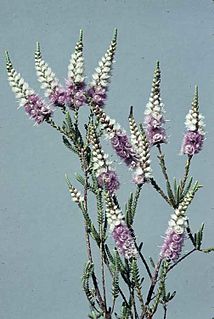
Verticordia spicata, commonly known as spiked featherflower, is a flowering plant in the myrtle family, Myrtaceae and is endemic to the south-west of Western Australia. It is usually a dense, bushy shrub with small leaves pressed against the stem and spikes of pink flowers from late spring to early summer.

Drosera erythrorhiza, the red ink sundew, is a perennial tuberous species in the carnivorous plant genus Drosera that is endemic to Western Australia. It grows in a rosette and is distinguished from the other species in section Erythrorhiza by its many-flowered cymose inflorescences with up to 50 individual flowers. D. erythrorhiza was first described by John Lindley in his 1839 publication A sketch of the vegetation of the Swan River Colony. In 1992, N. G. Marchant and Allen Lowrie described three new subspecies, thus also creating the autonym D. erythrorhiza subsp. erythrorhiza. The subspecies were separated from this variable species mostly by leaf morphology and distribution.

Isoquercetin, isoquercitrin or isotrifoliin is a flavonoid, a type of chemical compound. It is the 3-O-glucoside of quercetin. Isoquercitrin can be isolated from various plant species including Mangifera indica (mango) and Rheum nobile. It is also present in the leaves of Annona squamosa, Camellia sinensis (tea).and Vestia foetida

Reticuline is a chemical compound found in a variety of plants including Lindera aggregata, Annona squamosa, and Ocotea fasciculata. It is based on the benzylisoquinoline structure.
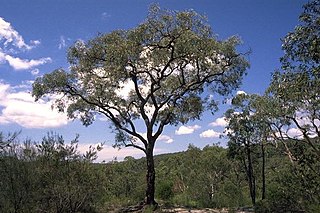
Eucalyptus squamosa, commonly known as scaly bark, is a species of small to medium-sized tree that is endemic to the Sydney region in New South Wales. It has rough, tessellated, fibrous or flaky bark, lance-shaped or curved adult leaves, flower buds in groups of seven, nine or eleven, white flowers and cup-shaped or hemispherical fruit.
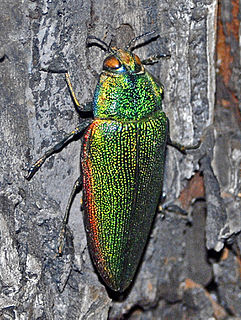
Steraspis squamosa or the Middle Eastern jewel beetle is a beetle of the Buprestidae family.
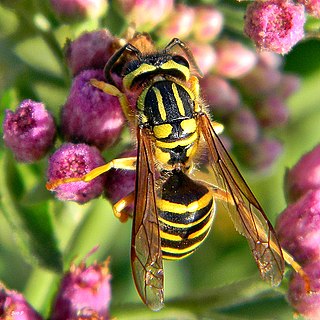
Vespula squamosa, the southern yellowjacket, is a social wasp. This species can be identified by its distinctive black and yellow patterning and orange queen. These yellowjackets are typically found in eastern North America, and its territory extends as far south as Central America. Within these territories, they create enormous, multiple-comb nests. The colonies may be either annual or perennial depending on the climate, and in many perennial nests, polygyny takes place. In addition, this species uses pheromones both as a sexual attractant and an alarm signal. This species feeds on insects and animal carcasses; it does not produce honey. V. squamosa, a social insect, has developed a parasitic relationship with the species V. vidua and V. maculifrons. Due to their painful, venomous stings, the species is considered a pest.
Caraphia is a genus of longhorned beetles in the family Cerambycidae, found in Central America.

Facheiroa squamosa is a species of Facheiroa from Brazil.
Caraphia lingafelteri is a species of beetle in the family Cerambycidae. It was described by Ohbayashi and Yamasako in 2016. It is found in Matagalpa Department in Nicaragua.
Caraphia seriata is a species of beetle in the family Cerambycidae. It was described by Chemsak and Linsley in 1984. It is found in Honduras and Guatemala.

Tetraclita squamosa, the green volcano barnacle, is a species of symmetrical sessile barnacle in the family Tetraclitidae.















